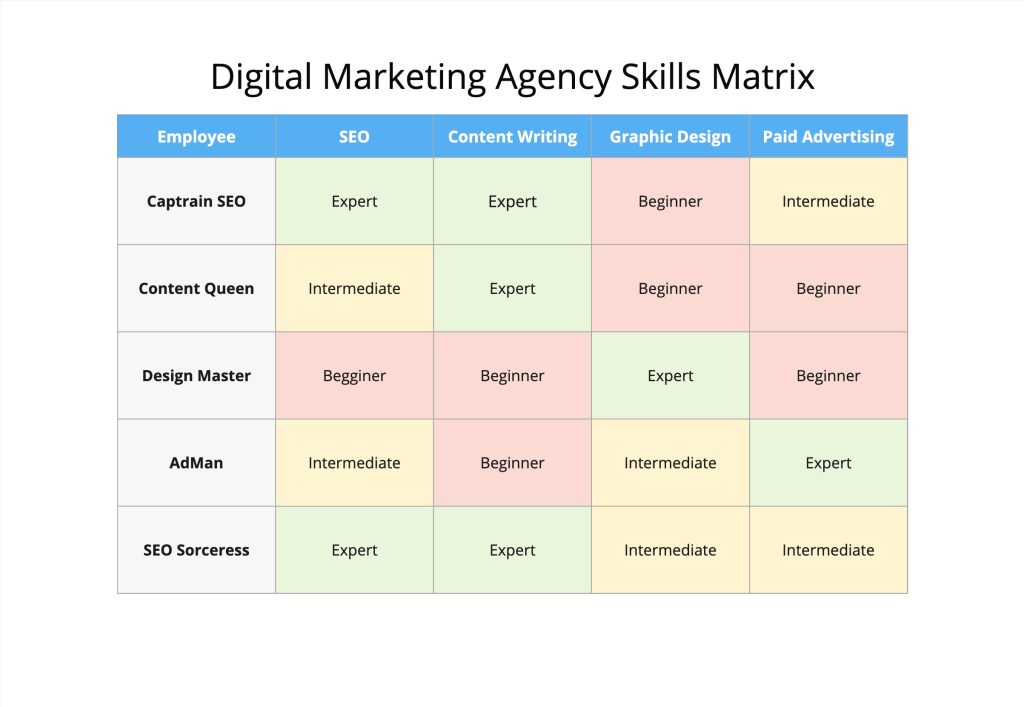
Why a Skills Matrix for Employees is Essential for Business Success
In today’s dynamic and fast-paced business environment, staying competitive requires more than just hiring skilled employees. It’s crucial for organisations to understand their workforce’s strengths and weaknesses to optimise performance and fill skill gaps effectively. One of the most effective tools for achieving this is the Skills Matrix. This article explores why a skills matrix is important and how it benefits both employees and organisations.
What is a Skills Matrix?
A skills matrix is a visual representation of the skills possessed by employees in a team or organization. Typically, it lists employees down one axis and the skills required for their roles across the other. The matrix is filled with data points, showing which employee has which skills, at what level, and where any skills gaps lie.
For example, in a digital marketing agency, the matrix might display skills such as SEO, content writing, graphic design, and paid advertising. The matrix will indicate which employees are proficient in which skills, highlighting the strengths and weaknesses across the team.

Key Benefits of Using a Skills Matrix
Identifies Skill Gaps and Training Needs
One of the most significant advantages of a skills matrix is its ability to identify gaps in skills. If your company is rolling out a new project requiring specific technical expertise, the matrix helps you quickly assess whether your team has the necessary skills. If not, it becomes evident who needs training.
For example, a software development company might have several skilled JavaScript developers but lacks employees with expertise in Python. This gap might hinder the company’s ability to handle new client requests or pivot toward different types of projects. With the help of a skills matrix, management can plan targeted training or hire new employees to fill the gap.
Improves Workforce Planning and Allocation
A skills matrix makes it easier to allocate resources based on your team’s strengths. By knowing exactly who excels in what area, managers can efficiently assign tasks that align with each employee’s skill set. This leads to better project outcomes and increases employee satisfaction, as they are more likely to enjoy and excel in tasks that match their abilities.
Consider a manufacturing company. If it knows that only a few workers are proficient with certain types of machinery, it can better plan schedules and avoid bottlenecks caused by waiting on specific employees to become available.
Enhances Employee Development and Career Growth
A skills matrix isn’t just about identifying what’s missing; it also highlights development opportunities for employees. If an employee is strong in one area but weak in another, it offers a pathway for personal development. This leads to better employee satisfaction, retention, and ultimately, business success.
For example, in a healthcare organisation, a nurse may excel at patient care but lack experience in administrative tasks. The matrix can be used to guide that nurse’s development, ensuring they are trained in a broader range of skills, which could eventually lead to more senior roles within the organisation.
Boosts Organisational Agility
In today’s dynamic market, companies need to pivot quickly in response to changing demands. A skills matrix helps organizations stay agile by ensuring they can quickly mobilize employees with the necessary skills to meet new challenges.
For instance, during the COVID-19 pandemic, many companies had to shift their operations rapidly. A skills matrix could have been used to identify which employees were adept at working remotely or had the skills to adapt to new technologies required for virtual work environments. This immediate insight allows for faster adjustments and smoother transitions.

Implementing a Skills Matrix in Your Business
Now that you understand why a skills matrix is essential, how do you go about implementing one?
Here’s a step-by-step guide to help you on your journey:

The steps above are a good starting point for creating and maintaining a skills matrix. You can add a few more checks and include additional considerations to make the process even more robust and effective.
Here are additional steps you might want to include:
Define Skill Levels and Metrics
- Clearly define what qualifies as Beginner, Intermediate, and Expert for each skill. This ensures consistency in evaluations across the organisation.
- Use quantifiable metrics where possible. For example, Intermediate in graphic design could be defined as someone who has completed five large-scale projects and is proficient in using specific software like Adobe Photoshop.
Incorporate Soft Skills
- It’s important to assess soft skills like communication, leadership, and time management, as they play a vital role in employee success. Include these in your matrix alongside technical skills.
- For example, you might rate an employee on their ability to lead a team or resolve conflicts effectively, using similar proficiency levels.
Link Skills to Business Objectives
- Identify which skills are critical to achieving specific business goals. This makes it easier to prioritise skill development and resource allocation.
- For example, if expanding your digital marketing services is a business objective, focus on increasing your team’s proficiency in paid advertising, SEO, and social media strategy.
Create a Skills Development Plan
- Based on the gaps identified in the matrix, create a skills development plan that includes training, mentorship, and workshops.
- Assign timelines for when specific skill gaps should be addressed and check in on progress regularly.
Involve Employees in the Process
- Encourage employees to self-assess their skills and provide feedback on areas where they’d like to grow. This can help them take ownership of their development.
- Regular feedback sessions can be useful in keeping the matrix updated and ensuring it accurately reflects each employee’s abilities.
Plan for Future Needs
- Predict future skills that may be required based on industry trends and company growth plans. Use the matrix to prepare for future projects or shifts in business strategy.
- For example, if you’re planning to move into AI-driven marketing, you might want to start building those technical capabilities in your current team.
Assess Team Collaboration
- Sometimes it’s not just about individual skills, but how well teams collaborate. You could include an assessment of how well employees work together or cover complementary skill sets within teams.
Use Technology for Automation
- Consider using specialised software to track and update the matrix more efficiently. Tools like Trello, Asana, or dedicated HR management systems, such as Skills Base , EdStellar can automate updates and allow for real-time skill tracking.
Review and Adjust Performance Metrics
- Ensure that employee performance reviews align with the skill levels indicated in the matrix. If employees are rated highly in skills but not performing accordingly, it may point to other underlying issues like motivation or workload.
A skills matrix is an essential tool for any business aiming to stay competitive and agile in a rapidly evolving marketplace. It helps you pinpoint skills gaps, plan more effectively, support employee development, and improve overall business performance. Whether you’re running a tech company, a healthcare organisation, or a small startup, a skills matrix will ensure you’re maximising the potential of your workforce.




